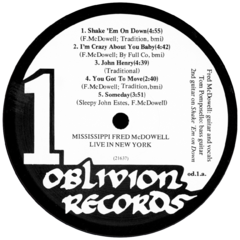- Oblivion Records
-
Oblivion Records Oblvion Records label 1972.png Founded 1972 Status dormant Genre blues, jazz, jazz fusion Country of origin United States Official Website www.oblivionrecords.tumblr.com Oblivion Records was an American independent record label that focused on under recorded blues and jazz musicians. The company was based in Huntington, New York and New York City and a post office box (Box X) in Roslyn Heights, New York from 1972–1976.
Contents
History
 LP label from the second edition of Oblivion's first release, Mississippi Fred McDowell: Live in New York, from 1972
LP label from the second edition of Oblivion's first release, Mississippi Fred McDowell: Live in New York, from 1972
The company was formed based on a casual conversation between Long Island, New York record store owner, musician, and blues scholar Tom Pomposello, and college student and amateur recording engineer Fred Seibert, when Pomposello was musing about the best way to record and release his music. Seibert incorrectly suggested a major label was a thing of the past and the way of the future was that Pomposello should record himself. The two quickly formed a partnership.[1]
Seibert hosted a Columbia University, WKCR-FM radio show[2], and had recorded Pomposello for his accompanying legendary country blues artist Mississippi Fred McDowell at The Gaslight Cafe in November 1971[3]. They agreed that the tapes were a commercial offering that could be used to launch the label. Pomposello suggested the tongue-in-cheek name Oblivion, cadged from an obscure Leo Kottke album, mistakenly believing the name to be a satire.[4]
Along with third partner Dick Pennington, who provided the initial financing, Oblivion released its maiden album, Mississippi Fred McDowell: “Live in New York” in the spring of 1972.
1972 also saw the release of the label’s only 45rpm single, “Johnny Woods: Mississippi Harmonica”[5] from Fred McDowell’s sometime musical partner, harmonica player Johnny Woods.[6]
Seibert’s interest was jazz, and by the end of 1972 the first jazz session was recorded, pointing the company towards the future. Marc Copland (then known as Marc Cohen) was a former Columbia student and mainstream jazz alto saxophone player[7] who came to WKCR with a trio and his saxophone plugged into an Echoplex and amplifier[8]. Seibert heard kinship with Miles Davis’, Tony Williams', and John McLaughlin's electronic experiments, and with the addition of guitarist John Abercrombie recorded one of the earliest “electronic jazz” records, soon to be known as jazz fusion. The album (five stars from Down Beat Magazine was named “Friends” (Copland felt it was a collective effort), with a cover by a Columbia University based "outsider" Sam Steinberg (artist)[9][10], it was Oblivion’s third release.[11]
Pomposello’s blues scholarship was increasing[12][13] and one area of particular interest was the state of the form in the immediate New York City metropolitan area, Oblivion’s home territory. Never a deep hotbed of traditional blues (Chicago, Illinois was the Northern U.S. center of the music), nevertheless New York had a reliable output over the postwar years by such artists as Elmore James, Wilbert Harrison, and Buster Brown. When guitarist & vocalist Charles Walker visited WKCR, Pomposello made it his mission to record him over a year’s time with various configurations of a dozen local players. ‘’Blues from the Apple’’ came out in 1974[14] and fittingly credited to “Charles Walker & the New York City Blues Band.”[15]
Joe Lee Wilson is a mainstream jazz vocalist who was making his name in Manhattan’s loft scene of the 1970s. He recorded a highly buzzed session at WKCR in 1972, which Oblivion launched as ‘’Livin’ High Off Nickels and Dimes’’, a New York jazz radio sensation in the autumn of 1974.[16]
End of the company
Oblivion’s last album had been its inspiration. ‘’Honest Tom Pomposello’’[17] was an album of true Americana, spanning from the expected blues, to folk and R&B, utilizing nine musicians recorded over two years.[18]
With only two reliably commercial records, Fred McDowell’s ‘’Live in New York’’ and Joe Lee Wilson’s ‘’Livin’ High Off Nickels and Dimes’’, Oblivion found it could no longer be sustained off the passions of its founders, the saga of many independent labels with inadequate capitalization. The company ceased operations in 1976.
References
- ^ Seibert, Fred. “A Very Brief History of Oblivion Records.”
- ^ Seibert, Fred. “WCKR and Oblivion.”
- ^ Seibert, Fred. “Our first recording.”
- ^ Seibert, Fred. “Why Oblivion?”
- ^ Kathleen Loves Music “Johnny Woods > Mississippi Harmonica.” [1]
- ^ Johnny Woods @ The Oblivion Records Blog
- ^ Seibert, Fred. ”Marc Cohen, electric alto saxophone and tenor saxophone.” [2]
- ^ Seibert, Fred. “The perfect combo for the next steps beyond.”
- ^ Seibert, Fred. “Sam Painted the ‘Friends’ Cover.”
- ^ Obituary, April 21, 1982. "Sam Steinberg, 85, a Peddler At Columbia for Generations"
- ^ ’’Friends’’ @ The Oblivion Records blog
- ^ Pomposello, Tom. "Mississippi Fred McDowell"
- ^ Pomposello, Tom. "Blues from the Big Apple"
- ^ ’’Blues from the Apple’’ @ The Oblivion Records blog
- ^ Kathleen Loves Music. ”Charles Walker & the New York City Blues Band > ’’Blues from the Apple’’” [3]
- ^ Kathleen Loves Music. ”Joe Lee Wilson > ’’Livin’ HIgh Off Nickels and Dimes’’” [4]
- ^ Kathleen Loves Music. ”’’Honest Tom Pomposello’’”
- ^ ”’’Honest Tom Pomposello’’” @ The Oblivion Records blog
External links
Categories:- American independent record labels
- Companies based in Suffolk County, New York
- Defunct companies based in New York City
- Record labels disestablished in 1976
- Record labels established in 1972
Wikimedia Foundation. 2010.
